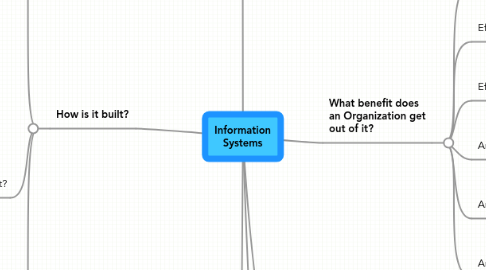
1. How is it built?
1.1. Information Systems Development Methodology
1.1.1. Requirement gather
1.1.1.1. Interview
1.1.1.1.1. Allows the system analyst to clarify responses and probe during face to face feedback
1.1.1.2. Observations
1.1.1.2.1. Helps the system analyst understand exactly how they perform
1.1.1.3. Document Review
1.1.1.3.1. Helps system the analyst to understand how exactly they perform a task
1.1.2. Analysis
1.1.2.1. Process modeling using DFD
1.1.2.1.1. How one process coordinates with another process
1.1.2.1.2. How one process works
1.1.2.2. Problem analysis using Ishikawa
1.1.2.2.1. Diagrams that show the cause of a certain event. Uses are product design and quality defect prevention.
1.1.3. Design
1.1.3.1. Design tools
1.1.4. Implementation
1.1.4.1. Programming Languages
1.1.4.1.1. Used to create and design programs using java, C++, C#, etc.
1.1.5. Maintenance and support
1.1.5.1. to provide ongoing assistance for an information system and its users after the system is implemented. Four major activities:Perform maintenance activities,Monitor system performance, Assess system security
1.2. Who are part of building it?
1.2.1. User
1.2.1.1. Interacts with the information system or uses the information it generates.
1.2.2. System Analysis
1.2.2.1. responsible for designing and developing an information system
1.2.3. Programmers
1.2.3.1. Converts the system design into the appropriate programming language
1.2.4. Project Leader
1.2.4.1. Manages and controls the budget and the schedule of the project.
1.3. What does it take for a professional to build one?
1.3.1. Team Work
1.3.1.1. is how well you work with your team to finish a task
1.3.2. Time Management
1.3.2.1. completing a task in a given amount of time
1.3.3. Project Management
1.3.3.1. Managing and controling the budget and the schedule of the project.
1.3.4. Communication Skills
1.3.4.1. is how well you give, receive, understand, and execute instructions
1.3.5. Interpersonal Skills
1.3.5.1. working well with other or new people
1.3.6. Leadership
1.3.6.1. leading your team to do all the work by motivating them and guiding them
2. What is it?
2.1. Solutions for organization
2.1.1. continue next page
3. What are its elements?
3.1. Process
3.1.1. Is the conversion of one thing into another
3.2. Data & Information
3.2.1. utilization of data to create information
3.3. People
3.3.1. Users, users of softwares and hardwares
3.4. Information Technology
3.4.1. Hardware
3.4.1.1. Electric, electronic, and mechanical components that a computer contains. Inputs devices are any hardware component that allows you to enter data. Output devices are any hardware component that allows you to convey information
3.4.2. Software
3.4.2.1. Also called a program. Consists of a series of related instructions, organized for a common purpose. Tells the computer what tasks to perform and how to perform them.
3.4.3. Storage
3.4.3.1. Holds data, instructions, and information for future use
3.4.4. Network & Communication
3.4.4.1. A network is a collection of computer and devices connected to each other. Usually wireless, via communication devices and transmission media. Allows the computer to share resources like hardware, software, data, and information
3.5. Strategy
3.5.1. Organized way of solving a given problem, Improvement, New service
4. What benefit does an Organization get out of it?
4.1. Organizational Productivity
4.1.1. Ensures the utilization of resources for maximum results
4.2. Effectively
4.2.1. Makes sure that the organization attains short- term and long- term goals and targets
4.3. Efficiently
4.3.1. The organization utilizes available resources and make the most out of it
4.4. Anywhere
4.4.1. You can do all the functions of an organization anywhere you would like to
4.5. Anytime
4.5.1. You can do the work anytime of the day because of the availability of information and technology
4.6. Any device
4.6.1. Allows you to work with multiple devices or change from one device to another
5. What does it provide?
5.1. Data
5.1.1. are facts used to create usable information
5.2. Information
5.2.1. Collected and logically interrelated data that are meaning full and factual
5.3. Knowledge
5.3.1. Realization from information given by a user or the analysis from the given information
6. General purpose
6.1. Transaction processing Information Systems
6.1.1. OLTP(Online Transaction Processing)- computer processes each transaction as it is entered, Captures and process daily business activities. One of the first computerized systems that processed business data
6.2. Management Information Systems
6.2.1. an information system that provides accurate, timely and organized information, evolved from transaction processing systems, focuses on creating information that managers and other users need to perform their jobs, Creates 3 basic reports: summary, detailed and exceptio
6.3. Decision Support Systems
6.3.1. Helps users analyze information and make decisions Programs that process data in DSS is called online analytical processing Uses data from internal sources and external sources
6.4. Executive Information Systems
6.4.1. A special type of DSS, Supports the strategic information needs of executive management, Presents information as charts and tables that show trends, ratios, statistics that aid in the decision making process.

